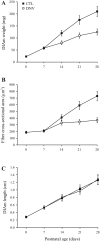Key aspects of phrenic motoneuron and diaphragm muscle development during the perinatal period
- PMID: 18403452
- PMCID: PMC3899579
- DOI: 10.1152/japplphysiol.01192.2007
Key aspects of phrenic motoneuron and diaphragm muscle development during the perinatal period
Abstract
At the time of birth, respiratory muscles must be activated to sustain ventilation. The perinatal development of respiratory motor units (comprising an individual motoneuron and the muscle fibers it innervates) shows remarkable features that enable mammals to transition from in utero conditions to the air environment in which the remainder of their life will occur. In addition, significant postnatal maturation is necessary to provide for the range of motor behaviors necessary during breathing, swallowing, and speech. As the main inspiratory muscle, the diaphragm muscle (and the phrenic motoneurons that innervate it) plays a key role in accomplishing these behaviors. Considerable diversity exists across diaphragm motor units, but the determinant factors for this diversity are unknown. In recent years, the mechanisms underlying the development of respiratory motor units have received great attention, and this knowledge may provide the opportunity to design appropriate interventions for the treatment of respiratory disease not only in the perinatal period but likely also in the adult.
Figures




Similar articles
-
The phrenic neuromuscular system.Handb Clin Neurol. 2022;188:393-408. doi: 10.1016/B978-0-323-91534-2.00012-6. Handb Clin Neurol. 2022. PMID: 35965035 Free PMC article. Review.
-
Diaphragm neuromuscular transmission failure in aged rats.J Neurophysiol. 2019 Jul 1;122(1):93-104. doi: 10.1152/jn.00061.2019. Epub 2019 May 1. J Neurophysiol. 2019. PMID: 31042426 Free PMC article.
-
Developmental plasticity of phrenic motoneuron and diaphragm properties with the inception of inspiratory drive transmission in utero.Exp Neurol. 2017 Jan;287(Pt 2):137-143. doi: 10.1016/j.expneurol.2016.05.017. Epub 2016 May 12. Exp Neurol. 2017. PMID: 27181410 Review.
-
Phrenic motoneuron morphology during rapid diaphragm muscle growth.J Appl Physiol (1985). 2000 Aug;89(2):563-72. doi: 10.1152/jappl.2000.89.2.563. J Appl Physiol (1985). 2000. PMID: 10926639
-
Invited review: Mechanisms underlying motor unit plasticity in the respiratory system.J Appl Physiol (1985). 2003 Mar;94(3):1230-41. doi: 10.1152/japplphysiol.01120.2002. J Appl Physiol (1985). 2003. PMID: 12571144 Review.
Cited by
-
Spinal TNF is necessary for inactivity-induced phrenic motor facilitation.J Physiol. 2013 Nov 15;591(22):5585-98. doi: 10.1113/jphysiol.2013.256644. Epub 2013 Jul 22. J Physiol. 2013. PMID: 23878370 Free PMC article.
-
Impact of inflammation on developing respiratory control networks: rhythm generation, chemoreception and plasticity.Respir Physiol Neurobiol. 2020 Mar;274:103357. doi: 10.1016/j.resp.2019.103357. Epub 2019 Dec 30. Respir Physiol Neurobiol. 2020. PMID: 31899353 Free PMC article. Review.
-
Tripartite purinergic modulation of central respiratory networks during perinatal development: the influence of ATP, ectonucleotidases, and ATP metabolites.J Neurosci. 2009 Nov 25;29(47):14713-25. doi: 10.1523/JNEUROSCI.2660-09.2009. J Neurosci. 2009. PMID: 19940166 Free PMC article.
-
Low back pain and gastroesophageal reflux in patients with COPD: the disease in the breath.Int J Chron Obstruct Pulmon Dis. 2018 Jan 17;13:325-334. doi: 10.2147/COPD.S150401. eCollection 2018. Int J Chron Obstruct Pulmon Dis. 2018. PMID: 29403270 Free PMC article.
-
Breathing: Motor Control of Diaphragm Muscle.Physiology (Bethesda). 2018 Mar 1;33(2):113-126. doi: 10.1152/physiol.00002.2018. Physiology (Bethesda). 2018. PMID: 29412056 Free PMC article. Review.
References
-
- Allan DW, Greer JJ. Development of phrenic motoneuron morphology in the fetal rat. J Comp Neurol. 1997;382:469–479. - PubMed
-
- Allan DW, Greer JJ. Embryogenesis of the phrenic nerve and diaphragm in the fetal rat. J Comp Neurol. 1997;382:459–468. - PubMed
-
- Arnold HH, Braun T. Genetics of muscle determination and development. Curr Top Dev Biol. 2000;48:129–165. - PubMed
-
- Babiuk RP, Greer JJ. Diaphragm defects occur in a CDH hernia model independently of myogenesis and lung formation. Am J Physiol Lung Cell Mol Physiol. 2002;283:L1310–L1314. - PubMed
-
- Babiuk RP, Zhang W, Clugston R, Allan DW, Greer JJ. Embryological origins and development of the rat diaphragm. J Comp Neurol. 2003;455:477–487. - PubMed
Publication types
MeSH terms
Grants and funding
LinkOut - more resources
Full Text Sources
Research Materials

